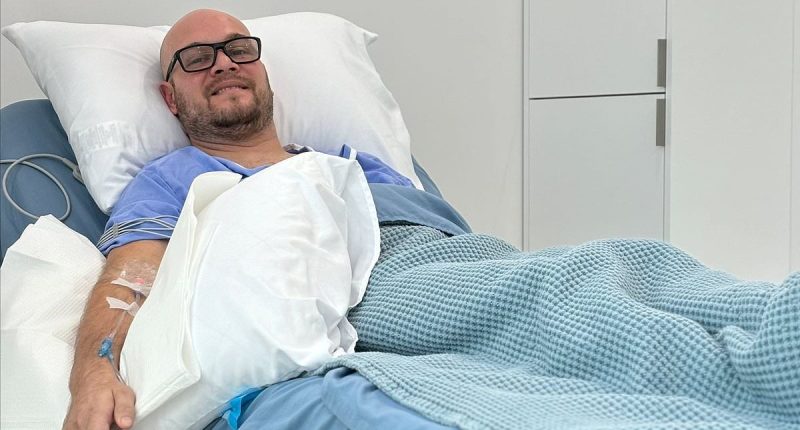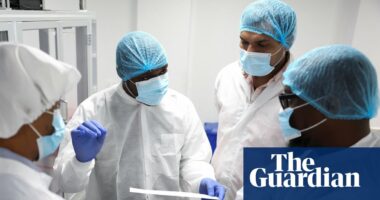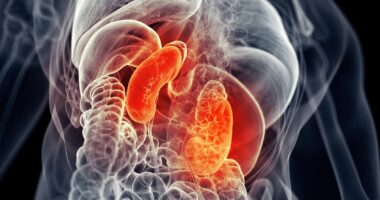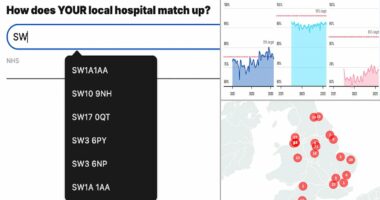Share this @internewscast.com
When Andres Albaladejo was hit by a sudden twitch in his left arm at just 39, he blamed it on a pinched nerve.
But the actual cause was an incurable, life-wrecking—and ultimately deadly—condition that gradually robs sufferers of their ability to move, talk and even eat.
Just eight months after his first warning shot, the now 41-year-old from Tampa in Florida, was diagnosed with amyotrophic lateral sclerosis (ALS) — the most common form of motor neurone disease.
ALS claimed the life of Sandra Bullock’s partner Bryan Randall in 2023 and the acclaimed scientist Stephen Hawking famously suffered from it.
Now, the former school resource officer has told of the early signs he suffered before his diagnosis, in an effort to raise awareness of the condition in young people.
Involuntary muscle twitching is one of the most common signs of ALS but can often be linked to stress and caffeine use.
The twitches can be subtle, strong enough to feel but unlikely to cause jerking or big, noticeable movements, and most commonly affect the eyelids, arms, hands, fingers, legs, and feet.
Recalling Mr Albaladejo’s heartbreaking diagnosis, his wife Carmen, who first noticed the twitch in April 2023, said: ‘It was bizarre. I asked if he could feel it, if he was doing anything to make it twitch, but he said no.

The results confirmed the heartbreaking diagnosis—the young father had ALS and was told he had two years to live

When Andres Albaladejo, 39 at the time, from Tampa Florida in America noticed a twitch in his left arm in April 2023, he didn’t think it was anything sinister
‘We thought it was a pinched nerve, but over time, he started experiencing arm weakness, and he wasn’t able to grip with his left arm.’
In June 2023, he went to the chiropractor, and an x-ray showed he had some nerve compression, which came as a relief to the couple.
But after his arm weakness failed to subside even after treatment, he was referred to a neurologist.
Mrs Albaladejo said: ‘At the time, the doctors said they were going to schedule him for a disc replacement surgery for the disc that was compressing his nerve.
‘But before they went ahead and did that, they did three Electromyography’s (EMGs) with the neurologist becoming more concerned each time as the twitching was traveling to his chest.’
An EMG is a medical test that measures the electrical activity in muscles.
Mr Albaladejo was then transferred to an ALS clinic, where he was diagnosed with the condition and giving a shocking prognosis of just two to five years.
He said: ‘I was heartbroken when I heard the news, like my life was being taken from me piece by piece – I still have so much of me to give.

The young father is spending whatever time he has left making as many memories as possible with his wife and 11-year-old daughter Sophia
‘I’m angry that I won’t be here to see my little girl grow into the smart, kind, and beautiful woman I know she will be. I think that hurts the most.
‘Instead, she has to watch me fall apart in front of her eyes.
‘I just hope that throughout all of this, my daughter still sees me as her hero, as I face this disease with determination and strength.’
Mrs Albaladejo added: ‘From having a pinched nerve to being diagnosed with a terminal disease eight months later—we were in shock and denial.
‘It was devastating, you can never imagine it happening to you or a loved one.
‘In eight months, our lives completely changed. We thought it was nerve compression, and now Andres has a terminal illness with a prognosis of two to five years.
‘It is a lot to hear in one appointment.’
Mr Albaladejo is currently taking an ALS medication to slow the progression of the disease.

There are currently no stem cell therapies for ALS available in the US approved by the regulator, the Federal Drug Agency (FDA)
His friends and family also raised $26,235 for him to get stem cell therapy in the Cayman Islands.
However, the effects have now worn off, Mrs Albaladejo noted and said they couldn’t afford another round of treatment.
She added: ‘We are facing the disease head-on and dealing with it every day.
‘At this point, we are getting our affairs in order, as we cannot see any promising treatments we can afford.
‘We are trying to stay strong and make the best out of our situation.’
The young father is spending whatever time he has left making as many memories as possible with his wife and 11-year-old daughter Sophia.
Around 5,000 adults in the UK have MND and there is a one in 300 risk of developing the condition over the course of a person’s life.
Life expectancy for about half of those with the condition is between just two and five years from the onset of symptoms. But these can worsen rapidly.
Some people may live for up to 10 years, and, in rarer circumstances, even longer.
Along with twitches, cramps and muscle weakness are among the early signs of the condition, along with slurred speech and weight loss.
There is no cure but doctors can provide treatments to help reduce the impact it has on a person’s life.
The exact cause is largely unknown, but current research points towards a complex interplay of genetic, environmental, and possibly lifestyle factors—and it often hits seemingly fit and healthy people.
Last year, Leeds Rhinos star Rob Burrow, 41, died after a four-and-a-half-year battle with the condition.















